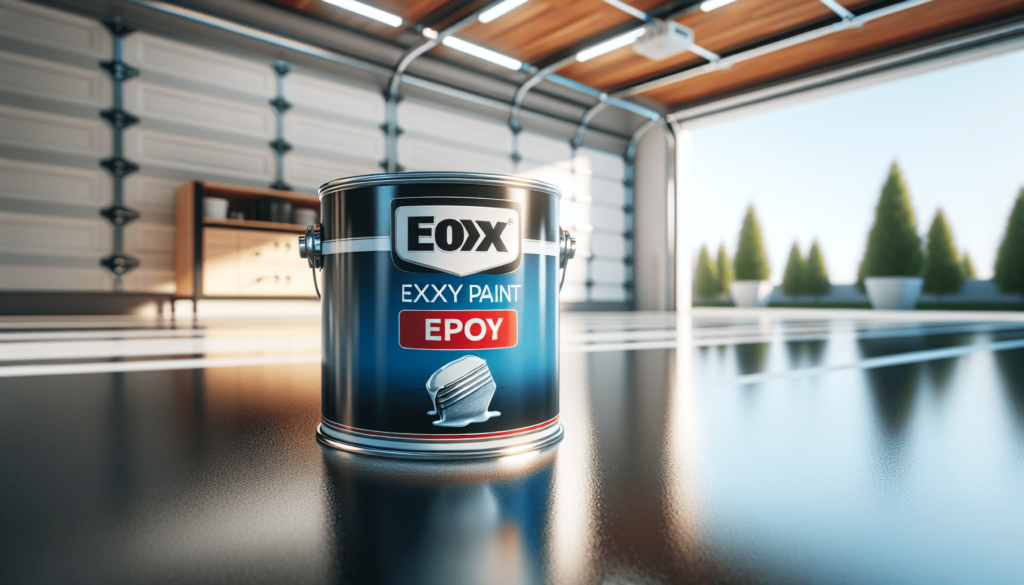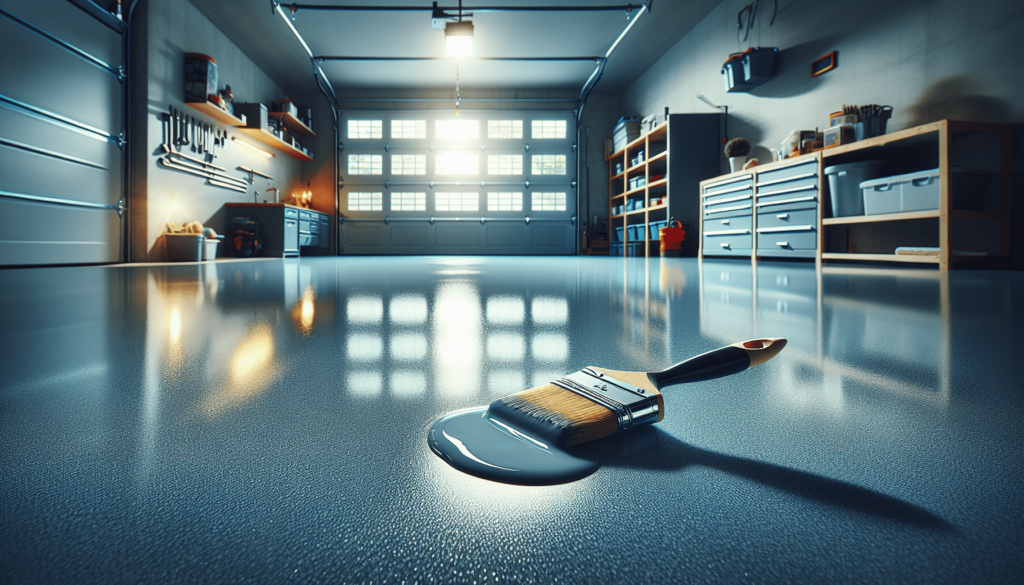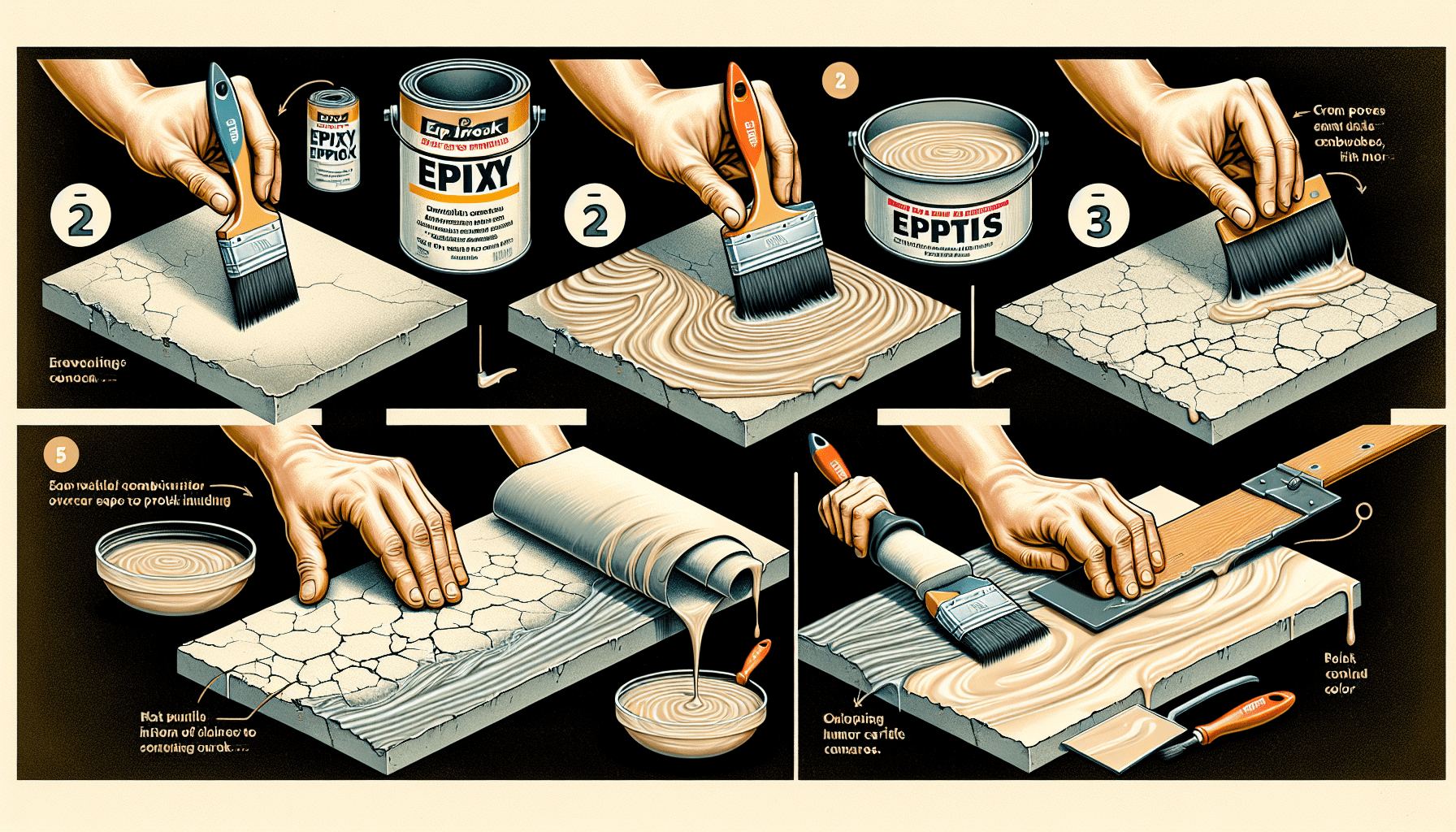Looking to give your garage floor a fresh and durable makeover? Look no further than epoxy paint. With its long-lasting and protective properties, epoxy paint provides a seamless and glossy finish that not only enhances the aesthetic appeal of your garage, but also adds an extra layer of durability to withstand heavy traffic and stains. In this article, you will learn the step-by-step process on how to paint a garage floor with epoxy paint, ensuring a professional and polished result that will last for years to come.

Preparing the Garage Floor
Clearing the Garage
Before you can begin painting your garage floor with epoxy paint, it is essential to clear out the space. Remove any vehicles, tools, or other items from the garage to create an empty workspace. This will allow you to have unobstructed access to the entire floor, ensuring a smooth and efficient painting process.
Cleaning the Floor
Once the garage is cleared, the next step is to thoroughly clean the floor. Sweep or vacuum the surface to remove any loose dirt, dust, or debris. For more stubborn stains or spills, you may need to use a mild detergent and a scrub brush. Rinse the floor with clean water and allow it to dry completely. A clean and properly prepared surface is crucial for the successful application of epoxy paint.
Repairing any Damage
Inspect your garage floor for any cracks, pits, or other damage. These imperfections should be repaired before applying epoxy paint to ensure a smooth and even finish. Use a concrete patching compound to fill in any cracks or holes, following the manufacturer’s instructions. Allow the repairs to dry completely before proceeding to the next step.
Etching the Surface
Etching the surface of the garage floor is an important step that helps the epoxy paint adhere effectively. Etching removes any existing sealers and opens the pores of the concrete, allowing the paint to penetrate and bond securely. You can use an etching solution, which is typically a combination of water and muriatic acid. Follow the manufacturer’s instructions and take proper safety precautions. After etching, rinse the floor thoroughly with water and allow it to dry completely.
Choosing the Right Epoxy Paint
Selecting the Type of Epoxy
When it comes to choosing epoxy paint for your garage floor, there are two main types: water-based and solvent-based. Water-based epoxy paints are generally easier to work with, have low odor, and provide a more eco-friendly option. On the other hand, solvent-based epoxy paints are highly durable and resistant to chemicals and abrasions. Consider your specific requirements and preferences to determine which type of epoxy paint is best suited for your garage floor.
Considering Color and Finish Options
Epoxy paints come in a variety of colors and finishes, allowing you to customize the look of your garage floor. Consider the overall aesthetic you want to achieve and select a color that complements the style of your garage. In addition, epoxy paints can be either glossy or matte, so choose a finish that suits your preferences. Keep in mind that glossy finishes tend to show more imperfections, while matte finishes offer a more forgiving appearance.
Calculating the Amount Needed
Before purchasing epoxy paint, it is crucial to calculate the amount needed for your garage floor. Measure the square footage of your floor by multiplying the length and width. Refer to the manufacturer’s coverage information, which typically indicates the square footage that a specific epoxy kit can cover. Make sure to account for multiple coats if necessary. It is always better to have slightly more paint than you need rather than running out in the middle of the project.
Gathering the Necessary Tools and Materials
Safety Equipment
Ensure your safety by wearing appropriate protective gear throughout the painting process. This may include goggles, gloves, a respirator mask, and suitable clothing to avoid skin contact with the epoxy paint or other chemicals.
Cleaning Supplies
In addition to the cleaning supplies used earlier, make sure you have a bucket, a stiff bristle brush, and a mop or sponge for the initial cleaning and preparation of the floor.
Repair Tools
To address any damage on the garage floor, you will need a concrete patching compound, a trowel for applying the compound, and a putty knife for smoothing the repairs.
Painting Tools
The main painting tools you will need include a roller and an extension pole, a paintbrush for cutting in the edges, and a paint tray or bucket for pouring the epoxy paint.
Painter’s Tape
Using painter’s tape to protect walls, baseboards, and any other areas where you don’t want the epoxy paint to reach is highly recommended. Ensure you have enough tape to cover the desired areas.
Drop Cloths or Tarps
To protect the surrounding area from any potential paint spills or splatters, lay down drop cloths or tarps. This will prevent any accidental damage to your belongings or the garage floor itself.
Applying a Primer Coat
Sweeping or Vacuuming the Surface
Before applying the primer coat, it is important to ensure the garage floor is clean and free of any loose debris. Sweep or vacuum the surface once again to remove any dirt or dust that may have accumulated during the preparation process.
Mixing the Primer
Follow the manufacturer’s instructions to mix the primer thoroughly. This may involve combining multiple components or activating the primer before use. Take note of the recommended mixing ratios and ensure you have the necessary tools, such as a drill with a mixing attachment.
Applying the Primer Coat
Using a roller and extension pole, apply the primer coat evenly over the entire garage floor. Start at the farthest corner and work your way toward the exit to avoid painting yourself into a corner. Make sure the primer is evenly distributed and covers the surface completely.
Allowing Sufficient Drying Time
Give the primer coat ample time to dry before proceeding to the next steps. Follow the manufacturer’s instructions for the recommended drying time, which is typically several hours or overnight. Avoid stepping on or touching the primed surface during this time to prevent any damage or imperfections.

Mixing the Epoxy Paint
Reading and Following Instructions
Carefully read the instructions provided by the manufacturer of your chosen epoxy paint. Pay close attention to any specific mixing instructions, curing times, and safety precautions. Following these instructions precisely will ensure the best results.
Mixing Ratios
Epoxy paints are typically a two-part system, consisting of a resin and a hardener. It is crucial to mix these parts in the correct ratios to achieve optimal performance. Use a scale or measuring containers to accurately measure and combine the resin and hardener as specified in the instructions.
Using a Drill or Mixer
To thoroughly mix the epoxy paint components, use a drill with a mixing attachment or a paint mixer specifically designed for epoxy paints. Mix the components at a slow speed to avoid creating air bubbles. Make sure the mixture is well blended and no streaks or clumps remain.
Painting the Garage Floor
Dividing the Floor into Sections
To ensure an organized and efficient painting process, divide the garage floor into manageable sections. This will help you maintain a consistent workflow and prevent the paint from drying prematurely.
Cutting in the Edges
Before starting with the roller, use a paintbrush to cut in the edges of each section. Apply the epoxy paint carefully along the walls and in the corners, ensuring a neat and precise finish. This step will make it easier to cover the remaining floor area with the roller.
Applying the First Coat
With the edges cut in, begin applying the epoxy paint using a roller and extension pole. Start in a corner and work your way across the section in a smooth, overlapping motion. Apply an even coat of paint, making sure to avoid any puddles or excess accumulation. The thickness of the first coat may vary depending on the manufacturer’s recommendations.
Allowing Drying Time
Once the first coat is applied, allow it to dry according to the manufacturer’s instructions. This typically involves waiting several hours before proceeding with additional coats. Take care not to walk on or disturb the freshly painted surface during this time to avoid any damage or imperfections.
Applying Additional Coats
If desired or recommended, apply additional coats of epoxy paint to achieve the desired durability and appearance. Follow the same process of cutting in the edges and using the roller to evenly apply the paint. Allow each coat to dry completely before adding another layer. Multiple coats will enhance the strength and longevity of the epoxy coating.
Adding Decorative Flakes (Optional)
Choosing Decorative Flakes
If you want to add a decorative element to your garage floor, decorative flakes are a popular option. These flakes come in various colors and sizes, allowing you to create a unique and visually appealing floor design. Select flakes that complement the color of your epoxy paint and the overall aesthetic of your garage.
Applying the Flakes
After applying the final coat of epoxy paint, it is time to add the decorative flakes. Sprinkle the flakes evenly over the wet paint surface, ensuring thorough coverage. You can use your hands or a shaker to distribute the flakes. Remember that the density of flakes will determine the overall appearance and texture of the floor.
Removing Excess Flakes
Once the flakes are applied, gently go over the surface with a soft broom or brush to remove any loose or excess flakes. This will help create a smooth and level finish. Be careful not to disrupt the flakes that have adhered to the wet paint.
Allowing the Flakes to Cure
After the flakes are applied, allow the entire floor to cure according to the manufacturer’s instructions. Curing times can vary, but it typically takes at least 24 to 48 hours for the epoxy paint and flakes to fully cure. Avoid walking on or moving any objects onto the floor during this time to prevent any damage.
Applying a Topcoat
To protect the flakes and give your garage floor a polished and glossy finish, apply a clear topcoat. Mix and prepare the topcoat according to the manufacturer’s instructions. Use a roller to apply the topcoat evenly over the entire floor, following the same techniques used for the epoxy paint. Ensure complete coverage and avoid creating pools or streaks.
Ensuring Even Coverage
When applying the topcoat, pay attention to achieving an even and consistent coverage. Take care to avoid overlapping or leaving gaps between roller strokes. This will ensure a uniform appearance and maximum protection for your garage floor.
Allowing Sufficient Curing Time
Once the topcoat is applied, allow it to cure for the recommended time specified by the manufacturer. This is typically 24 to 48 hours, but it’s essential to follow the specific instructions provided. Avoid any foot traffic or subjecting the floor to heavy objects during the curing process to allow the topcoat to fully harden and provide optimal durability.
Finishing Touches and Maintenance
Removing Painter’s Tape
After the entire floor has cured, carefully remove the painter’s tape from the walls, baseboards, and any other areas where it was applied. Use a utility knife or a paint scraper to ensure a clean and precise removal. Take your time to avoid damaging the paint or leaving any residue behind.
Cleaning and Organizing the Garage
Now that your garage floor is beautifully coated with epoxy paint, take the opportunity to clean and organize the space. Remove any remaining debris, dust, or dirt, and consider rearranging your tools and belongings for a more efficient and visually pleasing garage.
Avoiding Damage to the Epoxy Coating
To maintain the longevity and appearance of your epoxy-coated garage floor, it is important to take precautions to avoid damage. Avoid dragging heavy objects or sharp tools directly on the surface, as this can cause scratches or gouges. Place protective mats or pads under workbenches or vehicles to prevent any accidental damage.
Regular Cleaning and Maintenance
Regular cleaning and maintenance are key to preserving the beauty and durability of your epoxy-coated garage floor. Sweep or vacuum the floor regularly to remove any loose dirt or debris. For tougher stains or spills, clean the floor with a mild detergent and water. Avoid using harsh chemicals or abrasive scrub brushes, as these can damage the epoxy coating.
Common Mistakes to Avoid
Skipping Surface Preparation
One of the biggest mistakes when painting a garage floor with epoxy paint is failing to properly prepare the surface. Skipping steps such as clearing the garage, cleaning the floor, repairing damage, and etching can result in poor adhesion and a subpar finish. Take the time to thoroughly prepare the floor to ensure the best possible results.
Incorrect Mixing Ratios
It is crucial to follow the recommended mixing ratios when preparing and mixing epoxy paint components. Deviating from these ratios can lead to an improperly cured or weak coating. Use precise measurements and mixing techniques to achieve the correct consistency and performance of the epoxy paint.
Ignoring Drying and Curing Times
Rushing the drying and curing process can have negative consequences for your epoxy-coated garage floor. Avoid walking on the floor or moving objects onto it before the recommended drying and curing times have elapsed. Proper drying and curing times are essential for achieving a durable and long-lasting finish.
Incomplete Coverage
Applying an insufficient amount of epoxy paint can result in an uneven and weak coating. Ensure complete coverage by following the manufacturer’s instructions and applying the recommended number of coats. This will provide a more robust protection for your garage floor.
Poorly Maintaining the Coating
Neglecting the regular cleaning and maintenance of your epoxy-coated garage floor can lead to the deterioration of its appearance and performance. Make a habit of regularly sweeping or vacuuming the floor, and promptly clean up any spills or stains. By properly maintaining the coating, you can extend its lifespan and enjoy its benefits for years to come.
In conclusion, painting a garage floor with epoxy paint can transform a dull and worn-out space into a beautiful and functional area. Follow the proper steps of preparing the garage floor, choosing the right epoxy paint, gathering the necessary tools and materials, and applying the paint in a systematic manner. Remember to take safety precautions, read and follow the manufacturer’s instructions, and avoid common mistakes. With patience and attention to detail, you can achieve a professional-looking garage floor that is durable, easy to clean, and visually appealing.



